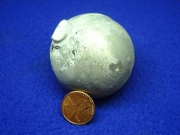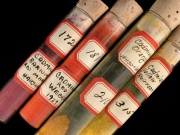Difference between revisions of "Cadmium"
(username removed) |
(username removed) |
||
| Line 2: | Line 2: | ||
== Description == | == Description == | ||
| − | A soft, blue-white metallic element. Cadmium has an abundance of about 0.1 ppm in the earth's crust. It primarily occurs as [http://cameo.mfa.org/materials/fullrecord.asp?name=cadmium | + | A soft, blue-white metallic element. Cadmium has an abundance of about 0.1 ppm in the earth's crust. It primarily occurs as [http://cameo.mfa.org/materials/fullrecord.asp?name=cadmium%20sulfide cadmium sulfide] (greenockite) or cadmium carbonate (otavite) in ores rich in [http://cameo.mfa.org/materials/fullrecord.asp?name=zinc zinc], [http://cameo.mfa.org/materials/fullrecord.asp?name=copper copper], or [http://cameo.mfa.org/materials/fullrecord.asp?name=lead lead]. The silvery metal was first isolated by Fredrich Stromeyer, a German chemist in 1817. Metallic cadmium is ductile and can be cut with a knife or rolled into a thin sheet. It slowly oxidizes in moist air to form cadmium oxide. Cadmium is used in soft solder alloys, in incandescent light filaments, and in nickel-cadmium batteries. It is also electroplated on iron and steel as a corrosion resistant coating. Cadmium salts have been used as [http://cameo.mfa.org/materials/fullrecord.asp?name=cadmium%20red red], orange, and [http://cameo.mfa.org/materials/fullrecord.asp?name=cadmium%20yellow yellow] pigments in ceramic glazes and paints. Additionally cadmium sulfide and cadmium selenide are used as infrared transparent plates for infrared analysis. |
[[File:cadmium 4up.jpg|thumb|Cadmium pigments]] | [[File:cadmium 4up.jpg|thumb|Cadmium pigments]] | ||
== Synonyms and Related Terms == | == Synonyms and Related Terms == | ||
| − | Cd; cadmia (Lat.); cadmio (It., Esp.); | + | Cd; cadmia (Lat.); cadmio (It., Esp.); Cádmio (Port.); Kadmio (Sven.); Kadmium (Deut.) |
== Other Properties == | == Other Properties == | ||
| Line 54: | Line 54: | ||
* ''Van Nostrand's Scientific Encyclopedia'', Douglas M. Considine (ed.), Van Nostrand Reinhold, New York, 1976 | * ''Van Nostrand's Scientific Encyclopedia'', Douglas M. Considine (ed.), Van Nostrand Reinhold, New York, 1976 | ||
| − | * | + | * Random House, ''Webster's Encyclopedic Unabridged Dictionary of the English Language'', Grammercy Book, New York, 1997 |
* ''The American Heritage Dictionary'' or ''Encarta'', via Microsoft Bookshelf 98, Microsoft Corp., 1998 | * ''The American Heritage Dictionary'' or ''Encarta'', via Microsoft Bookshelf 98, Microsoft Corp., 1998 | ||
| Line 60: | Line 60: | ||
* ''Chemical & Engineering News'', American Chemical Society, Washington DC, 81 (36) , Sept. 8, 2003 Comment: Robert L. Wolke, p. 120 | * ''Chemical & Engineering News'', American Chemical Society, Washington DC, 81 (36) , Sept. 8, 2003 Comment: Robert L. Wolke, p. 120 | ||
| − | * | + | * Richard S. Lewis, ''Hawley's Condensed Chemical Dictionary'', Van Nostrand Reinhold, New York, 10th ed., 1993 |
* ''The Merck Index'', Martha Windholz (ed.), Merck Research Labs, Rahway NJ, 10th edition, 1983 Comment: entry # 1583 | * ''The Merck Index'', Martha Windholz (ed.), Merck Research Labs, Rahway NJ, 10th edition, 1983 Comment: entry # 1583 | ||
| − | * | + | * G.S.Brady, ''Materials Handbook'', McGraw-Hill Book Co., New York, 1971 Comment: p. 135 |
| − | * | + | * Michael McCann, ''Artist Beware'', Watson-Guptill Publications, New York City, 1979 |
[[Category:Materials database]] | [[Category:Materials database]] | ||
Revision as of 06:27, 24 July 2013
Description
A soft, blue-white metallic element. Cadmium has an abundance of about 0.1 ppm in the earth's crust. It primarily occurs as cadmium sulfide (greenockite) or cadmium carbonate (otavite) in ores rich in zinc, copper, or lead. The silvery metal was first isolated by Fredrich Stromeyer, a German chemist in 1817. Metallic cadmium is ductile and can be cut with a knife or rolled into a thin sheet. It slowly oxidizes in moist air to form cadmium oxide. Cadmium is used in soft solder alloys, in incandescent light filaments, and in nickel-cadmium batteries. It is also electroplated on iron and steel as a corrosion resistant coating. Cadmium salts have been used as red, orange, and yellow pigments in ceramic glazes and paints. Additionally cadmium sulfide and cadmium selenide are used as infrared transparent plates for infrared analysis.
Synonyms and Related Terms
Cd; cadmia (Lat.); cadmio (It., Esp.); Cádmio (Port.); Kadmio (Sven.); Kadmium (Deut.)
Other Properties
Reacts with acids. Insoluble in water and alkalis.
| Composition | Cd (atomic no. 48) |
|---|---|
| CAS | 7440-43-9 |
| Mohs Hardness | 2.0 |
| Melting Point | 320.9 |
| Density | 8.462 |
| Molecular Weight | atomic wt = 112.41 |
| Refractive Index | 1.13 |
| Boiling Point | 765-767 |
Hazards and Safety
Combustible. Metal and salts are highly toxic by ingestion and inhalation. Carcinogen.
LINK: International Chemical Safety Card
Additional Information
Web Elements: Website
Authority
- Van Nostrand's Scientific Encyclopedia, Douglas M. Considine (ed.), Van Nostrand Reinhold, New York, 1976
- Random House, Webster's Encyclopedic Unabridged Dictionary of the English Language, Grammercy Book, New York, 1997
- The American Heritage Dictionary or Encarta, via Microsoft Bookshelf 98, Microsoft Corp., 1998
- Chemical & Engineering News, American Chemical Society, Washington DC, 81 (36) , Sept. 8, 2003 Comment: Robert L. Wolke, p. 120
- Richard S. Lewis, Hawley's Condensed Chemical Dictionary, Van Nostrand Reinhold, New York, 10th ed., 1993
- The Merck Index, Martha Windholz (ed.), Merck Research Labs, Rahway NJ, 10th edition, 1983 Comment: entry # 1583
- G.S.Brady, Materials Handbook, McGraw-Hill Book Co., New York, 1971 Comment: p. 135
- Michael McCann, Artist Beware, Watson-Guptill Publications, New York City, 1979

